
Another pollinator, this time a bumble bee (Bombus sp.). For my money, bumble bees are perhaps the most attractive of all insects. Unfortunately, this individual was very active, and as a result most of my photos of it were blurry.
Yet Another Unitarian Universalist
A postmodern heretic's spiritual journey.

Another pollinator, this time a bumble bee (Bombus sp.). For my money, bumble bees are perhaps the most attractive of all insects. Unfortunately, this individual was very active, and as a result most of my photos of it were blurry.

A bee, probably a species in the genus Halictus, in a blossom of a California Poppy. There are over 200 species in the genus Halictus; since I didn’t collect a specimen and don’t have a dissecting microscope, I won’t attempt to determine which species. It’s enough for me to have seen the bee, and admired it.
…on Nov. 15, 1969, Son House was recorded live, performing “Death Letter Blues,” “John the Revelator,” “Preachin’ the Blues,” and “I Wanna Live so God Can Use Me.” House accompanies himself on guitar on the first and third songs; the other two are a capella. Since he was Son House, he did a little preaching too. All four songs are worth listening to, but the first song, “Death Letter Blues,” is my favorite. Listen on Youtube.
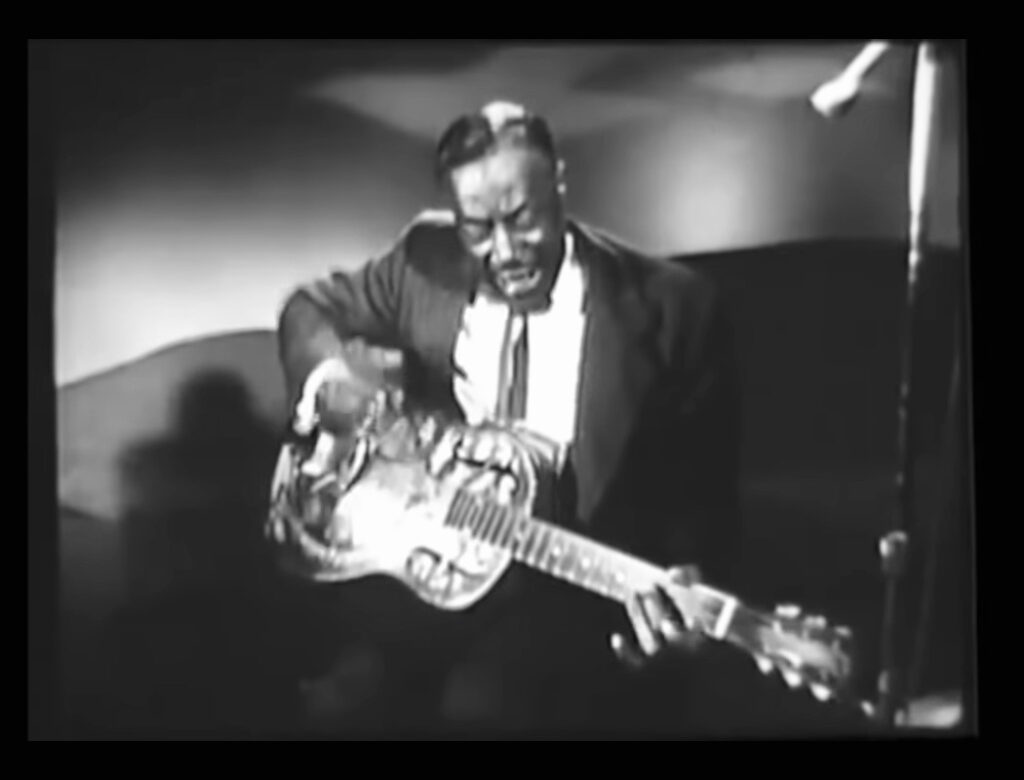
Yesterday I went for a walk along Charleston Slough in Palo Alto at high tide. It was a gray day, and the light seemed to make the colors of the ducks appear more dramatic than usual. Looking at the ducks helped me forget the crazy stuff that’s in the news these days.



Notes: Common and Latin names from Dunn and Alderfer, Field Guide to the Birds of North America, 7th ed. (2017); however, the AOU now assigns American Wigeon to its own genus, Mareca. Photos: inexpensive superzoom camera (cheaper than your smart phone) and free image manipulation software.
A week-long event called “Reimagine End of Life” is taking place in San Francisco right now. As a part of this, Carol and Ms. M. will offer a workshop on Saturday called “It’s a Wrap: Design Your Own Burial Shroud.” The point of the workshop is not to make the actual shroud you’re going to be buried in, but to start thinking about a design for something that you’d like to be wrapped up in after you die.
Tonight, Carol and I decided to play around with some materials and try a few things out. So we went down to Joanne Fabric and got 3 yards of 90 inch-wide unbleached cotton muslin, and a couple dozen different colored fabric markers. We wrapped Carol up in the muslin to see how much cloth was needed, and discovered that 2 yards of 110 inch fabric worked. (But if I were to do this again, I’d use a 90 inch square. And if I were making one for myself — Carol’s five foot nine inches tall, but I’m six foot five — I’d probably want a 110 inch square of fabric.)
Carol lay on the cloth diagonally. I flipped up the corner down by her feet first, folded over one side then the other side, and finally flipped the top corner down over her face. After flipping the corners back down, I used a pencil to make faint lines about where I folded the fabric; then when I started drawing, I knew about where to draw the designs.
Carol wanted to draw a face, but I said that would be far too difficult. Instead, she let me draw an abstract design within an oval shape:
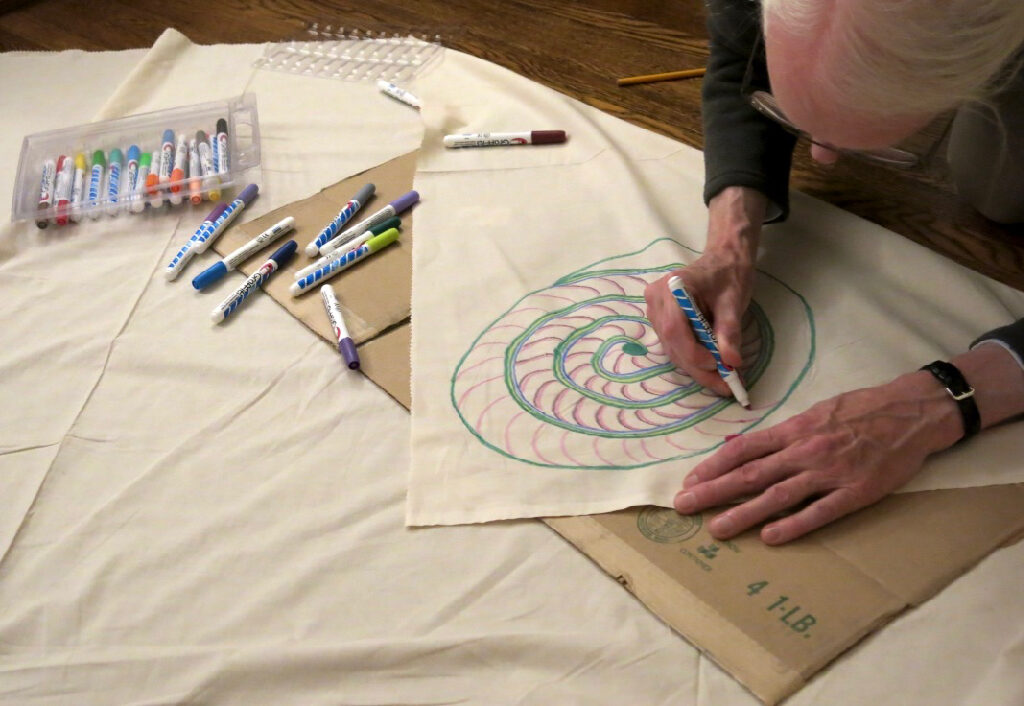
Next I drew a design on the final flap of fabric that would be folded over her body. Ultimately, I suppose you could draw designs over the entire piece of fabric. But most of what would be exposed would be those two flaps of fabric, as you can see in the photograph below:
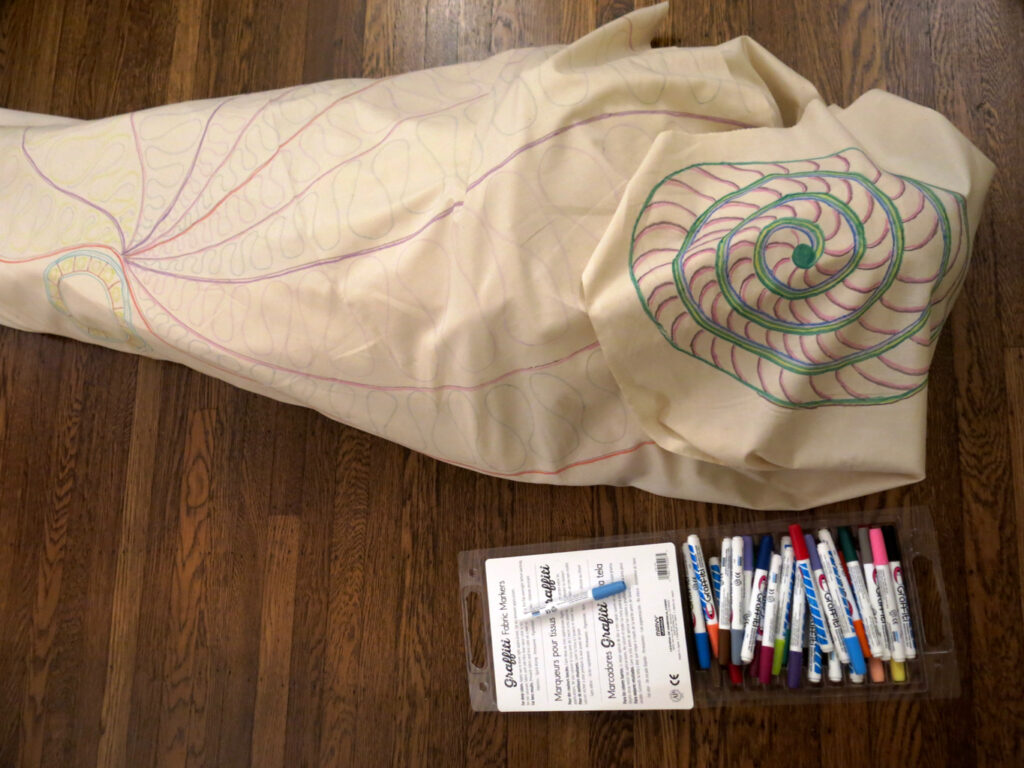
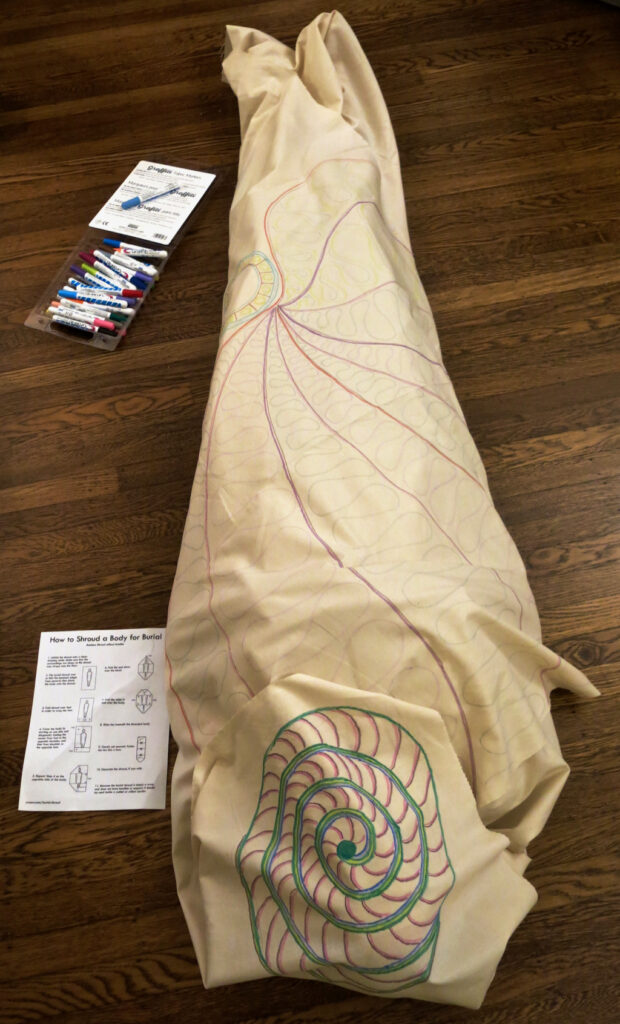
(That took me about an hour. But I have excellent hand skills, and years of training and experience in making art; someone with less experience could easily take two hours to get that far.)
To complete the shroud shown in the photo, I’d use fabric paint to fill in the design — perhaps a light wash inside the drawing at the head, with a dark bold color outside it; and then a light wash inside and around the swirls in the part over the body. If I wanted a more carefully crafted shroud, I’d get another piece of fabric and hem all the edges, and repaint the design on the hemmed fabric.
Really, though, for me this isn’t about coming up with a carefully-crafted final product. It was very pleasant working with these materials, and it was a chance to reflect on — not on death so much as to reflect on the entire life cycle.
Cost: 90 inch cotton muslin is about US$8 a yard. A nice set of fabric markers is going to set you back $20-35. If you want to use paints, that will cost you about $3 per color (for good-but-not-expensive paints). If you want to try stamping or printing with dyes, expect to pay about $45 for a starter kit.
Registration is closed on the workshop, but if you contact Carol directly ASAP, she might be able to get you in.
Update: 1/13/22 — There are now two requests for this post in come other format (see comments). So I made a PDF version which should be easy to download. Just click on the link above, or the preview below.
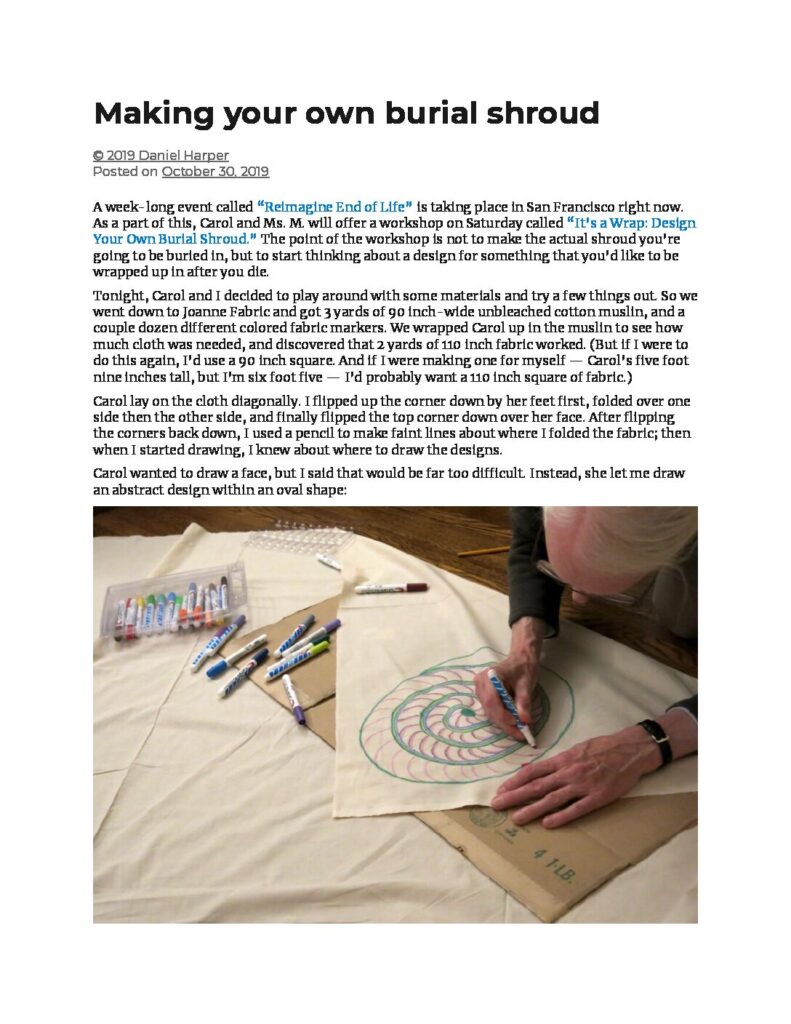
PG&E, the utility that everyone in northern California loves to hate, is going to shut down our power tonight, due to a forecast of high winds that could cause a downed wire that could in turn spark wildfires.
Why does PG&E have to shut down the power? Because they are owned by hedge funds, which demand maximum short-term profit instead of efficient running of a utility company, and they have skimped on power line maintenance for decades. Or, to put it more pointedly, as the governor of California recently said about PG&E: “Years of mismanagement, years of greed.”
Power could go out very soon, so I’m setting up the propane stove so I can cook dinner.
Lorraine forwarded an article from a local newspaper about the Silicon Valley Youth Climate Strike, which is organizing a march on Friday, September 20. Lorraine and I are co-directors of Ecojustice Camp, an annual week-long ecology camp run from the UU Church of Palo Alto, and Lorraine noticed that Peri Platenberg, one of the co-organizers of the march, is a junior counselor at Ecojustice Camp. Peri is also a member of the UU Fellowship of Sunnyvale. Here’s one of my favorite quotes from the article:
“One of our main goals is to make sure that we combat environmental racism,” Plantenberg said. “It’s traditionally a very whitewashed movement. We make it a priority to take a look at who is around us and make sure that we are including different ethnicities and different types of people.”
Read the full article here.
In Isaac Asimov’s memoir, I. Asimov, published in 1994, he explained why he was a political liberal:
“I wanted to see the United States changed and made more civilized, more humane, truer to its own proclaimed traditions I wanted to see all Americans judged as individuals and not as stereotypes. I wanted to see all with reasonable opportunities. I wanted society to feel a reasonable concern for the poor, the unemployed, the sick, the aged, the hopeless.”
Then, Asimov surveyed the political landscape over his lifetime:
“I was only thirteen when Franklin Delano Roosevelt became president and introduced the ‘New Deal,’ but I was not too young to get an idea of what he was trying to do. … I disapproved of Roosevelt only when he wasn’t liberal enough, as when, for political reasons, he ignored the plight of African Americans….
“Liberalism began to fade after World War II. Times became prosperous, and many blue collar people … turned conservative. They had theirs and weren’t willing to discommode themselves for those who were still down at the bottom….
“And eventually we came to the Reagan era, when it became de rigeur not to tax but to borrow; to spend money not on social services but on armaments. … Rich Americans grew richer in an atmosphere of deregulation and greed, and poor Americans — But who worries about poor Americans except people branded with the L-word that no one dared mention any more?
“It makes me think of Oliver Goldsmith’s lines:
Ill fares the land, to hastening ills a prey,
Where wealth accumulates, and men decay.
“As a loyal American, I grow heartsick.”
Asimov wrote that a quarter of a century ago, and things have mostly gotten worse since then. Perhaps there have been modest gains in people being judged as individuals and not stereotypes, most notably in the legaization of same sex marriage; but we have also learned from Black Lives Matter and #MeToo that far too many persons are victimized because of their race or sex. But when it comes to “a reasonable concern for the poor, the unemployed, the sick, the aged, the hopeless,” we have arguably regressed since 1994: Bill Clinton eviscerated aid to poor people, George W. Bush spent hundreds of billions of dollars in Iraq while cutting social service spending at home, Barack Obama put more effort into bailing out banks during the Great Recession than helping the poor, and Donald Trump now promotes open contempt of anyone who is not wealthy.
I continue to be a deeply patriotic American, but we are growing less civilized and less humane, and we are departing wildly from our proclaimed traditions. As a loyal American, I grow heartsick.
Happy Independence Day.
Geographer Richard A. Walker, in his 2018 book “Portrait of a Gone City: Tech and the Dark Side of Prosperity in the San Francisco Bay Area,” writes:
“The Great Recession has been calamitous. The official U.S. government designation of a two-year lapse in growth 2008-2010 minimizes the reality….things are worse than that. The Great Recession won’t go away — regardless of the soaring stock market and falling unemployment. By any measure, recovery from the Great Recession was the slowest from any crisis on record, including the Great Depression of the 1930s [emphasis mine]. U.S. productivity remains poor overall, aggregate demand is weak because wages have barely budged, and corporations are not investing with any gusto. Loose talk of full employment by mid-decade ignores the fact that so many Americans have dropped out of the labor force entirely.” (pp. 64-65).
Two conclusions for congregations: (1) Expect fundraising to be an ongoing challenge, since many households have not recovered from the Great Recession. (2) Expect the need for congregationally-based social services such as food pantries and supporting homeless shelters will continue to be robust. In other words, we will have to continue to do more with fewer resources.
People are starting to pay increasing attention to the dangers of plastic waste in the environment. I think children and teens are ahead of many adults in their awareness of the dangers of plastic waste — a six year old of my acquaintance asked for her sixth birthday party to be a plastics clean up on the beach. Now admittedly most of the children and teens that I know are from Unitarian Universalist families, so perhaps they are slightly more aware of plastic waste; but I think while many adults have gotten locked into a narrow focus on stopping further global warming, the children and teens I know seem more aware of the many interlocking aspects of looming global environmental disaster: global warming, plastic waste, toxics in the environment, habitat destruction, etc. And the kids I know quickly make the connection between all these problems and human overpopulation.
On the last day of our church’s Ecojustice Camp, we did a clean-up of the campsite where we spent the last night of camp. This was a well-maintained and relatively clean campsite, yet we found quite a bit of plastic waste:
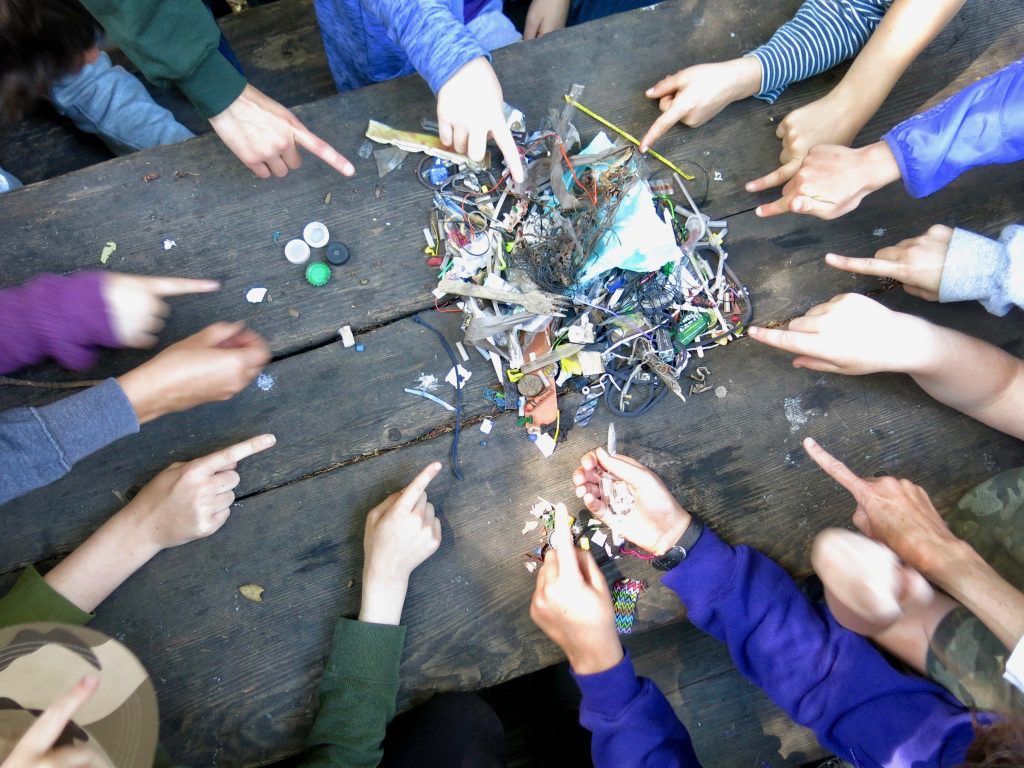
The campers and counselors found on the order of 200 pieces of plastic waste, along with some degradable trash such as paper and metal. That’s a lot of plastic….